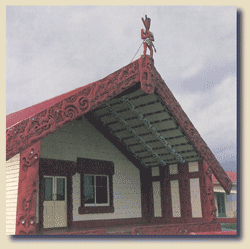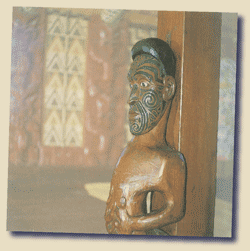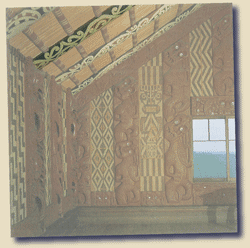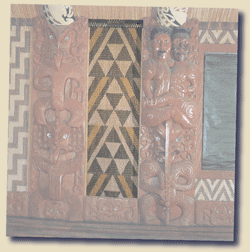|
||||||||||
|
||||||||||
Questions/instructions:
|
||||||||||
| %
responses |
||||||||||
|
||||||||||
| 1.
E möhio ana koe ki te ingoa o tënei wähanga? Do you know what this part is called? |
named the part “poutokomanawa” |
16 |
||||||||
named
the part “a carving” |
10 |
|||||||||
| 2.
Ki töu whakaaro, i mahia mai i te aha? What do you think this is made from? |
identified
material as wood |
90 |
||||||||
| 3.
He tino wähanga tënei o te wharenui. He aha ai? Why is this an important part of this meeting house? |
represents
ancestors (and their importance to the community) |
21 |
||||||||
welcomes
guests entering the house |
9 |
|||||||||
the
heart of the meeting house |
11 |
|||||||||
central
support/post of the house |
45 |
|||||||||
|
||||||||||
| 4.
E möhio ana koe ki te ingoa o tënei wähanga? Do you know what this is called? |
named
the part “kowhaiwhai” |
18 |
||||||||
named
the part “heke” |
4 |
|||||||||
| 5.
Ki töu whakaaro, i mahia mai i te aha? What do you think this is made from? |
paint/dyes
|
38 |
||||||||
wood
|
94 |
|||||||||
| 6.
He tino wähanga tënei o te wharenui. He aha ai? Why is this an important part of this meeting house? |
genealogy,
descent, whakapapa |
13 |
||||||||
ribs
of ancestors |
40 |
|||||||||
tells
a story |
9 |
|||||||||
|
||||||||||
| 7.
E möhio ana koe ki te ingoa o tënei wähanga? Do you know what this is called? |
named
the part “tukutuku” |
30 |
||||||||
named
the part “a (woven) wall panel”
|
0 |
|||||||||
named
the part “pakiwaitara” (story board)
|
2 |
|||||||||
| 8.
Ki töu whakaaro, i mahia mai i te aha? What do you think this is made from? |
traditional
materials (e.g. pingao/sand/sedge, harakeke/flax) |
48 |
||||||||
modern
alternative materials (e.g. wool, leather, plastic, raffia, string) |
29 |
|||||||||
| 9.
He tino wähanga tënei o te wharenui. He aha ai? Why is this an important part of this meeting house? |
balances
the efforts/contributions of woman and man |
0 |
||||||||
traditionally
symbolises working together/relationships |
2 |
|||||||||
balances/separates
carvings |
4 |
|||||||||
embellishment/sign
of the industriousness of makers |
4 |
|||||||||
tells
a story |
26 |
|||||||||
| Commentary:
The results provide useful information about the extent of students' knowledge of the meaning or significance of structures in a traditional Mäori meeting house. |
||||||||||
|
|
|
|



